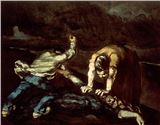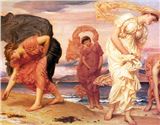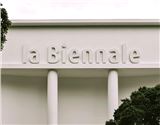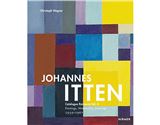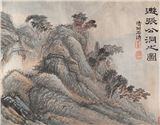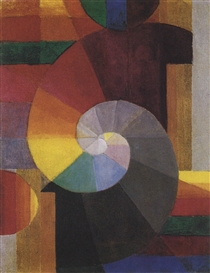Book Review: Johannes Itten, Elevated Avant-Garde
Johannes Itten’s experiments in color theory and his contributions to the Bauhaus are meticulously documented in an effort to enhance historical value
Michael Pearce / MutualArt
Apr 12, 2024
Johannes Itten – Catalogue Raisonné, Christoph Wagner. Hirmer.
What is the purpose of a catalogue raisonné? Simply, it is to provide a rationale for the inclusion of works of art in the catalogue of an artist’s entire oeuvre, to precisely define the extent of the artist’s work. But a catalogue raisonné also contributes to the mythos that builds an artist’s reputation – its creation is a statement of the significance of the artist to art history. That the artist’s work merits so detailed an examination implies that they are worthy of the attention of the scholars who dedicate a significant portion of their lives to this form of memorialization. Thus, any catalogue raisonné arrives with an implicit question – does the artist truly deserve this kind of attention? Does the artist merit canonization?
Although only the first two books of Wagner’s three-volume catalogue raisonné of the work of Johannes Itten are presently available, when the third is published in June 2024 this will doubtlessly be a beautifully produced trio of books, solidly bound, carefully printed, and researched with the solid gravitas of institutional scholars, generously funded by Itten’s descendants and other un-named sources.
Itten is best known for his highly influential book on color theory, and for his role as a principal character in the Bauhaus, the German school of design, arts, and crafts established by Walter Gropius in 1919, whose story has swelled to mythic proportions with the passing of time. On the insistence of Alma Mahler, Itten was appointed by Gropius as Master of Form at the Bauhaus, where he inflicted his cultish ideas upon students in his Vorkurs, a preliminary introductory course required for all enrollees. Itten was a devotee of Mazdaznan, an alternative religion based on the fiery ideas of Zoroastrianism, then flourishing in the bohemian circles of Weimar Germany, and required his students to endure a regime of cleansing enemas, vast amounts of garlic, and a vegetarian diet. Some of them imitated his home-made robes and shaved their heads. The nominal purpose of the Vorkurs was to liberate students from their previous knowledge, effectively indoctrinating them with the new spiritual wisdom of the Bauhaus, which increasingly coincided with Itten’s own esoteric faith as time passed.
The authors flag the inclusion of two of Itten’s paintings in the infamous National Socialist Entartete Kunst exhibit as a bright badge of virtue, adhering to the false narrative of American propaganda which governed the history of art in the 20th century. Following the doctrine that my enemy’s enemy is my friend, all artists whose work appeared in the exhibit were lionized by the American academy, whose members were enthusiastic participants in Nelson Rockefeller and Franklin Roosevelt’s construction and promulgation of the individualist avant-garde as American doctrine. A 1937 propaganda piece in The New York Times attempted to persuade Americans that National Socialist efforts to discredit the modernists had failed, claiming as evidence that Entartete Kunst was attended by crowds three times greater than those who went to the Great German Art show. In 1991, for a reconstruction of the show at the Los Angeles County Museum of Art (LACMA) and the Chicago Art Institute, disingenuous publicists used similar hyperbole to sell the challenging idea that modern art was actually popular in National Socialist Germany. And in a sense, the Entartete Kunst show was popular – but not for the reasons claimed by the American academy or press in either instance. It was certainly not popular because the people visiting the gallery admired the paintings and sculptures, as almost a century of American apologists for modernism would claim – but for precisely the opposite reason. The audience willingly came to the show because they were encouraged to deride individualist artists by Nazi Party propagandists, because their bias against modernism was confirmed and supported, and because the show perfectly fit National Socialist pedagogy. Entartete Kunst was popular as a theater of hate. School parties and Hitler Youth groups flocked to the display in organized field trips because of its clear match to the anti-Semitic and anti-Communist indoctrination that dominated their education.
The publishers boast that when complete, the three volumes will record more than three thousand works, and the biography will have referred to over one hundred thousand biographical documents and sources. But is quantity a true sign of quality or influence? Many of the works of Itten are crude explorations of his theories of color and pattern, and reflect his research of metaphysics and art. His early drawings show a dexterous, if uninspiring hand, competently trained in the German academic tradition, while his paintings were quickly influenced by the loose handling of crude modernism, but lacked the light or color of more inspired artists of the period. Soon, Itten abandoned figurative drawing, which was his only strength, and Volume One is bereft of any imagery that is not derivative or uninspired – despite his interest in transcendence and fiery Zoroastrian meditative mysticism, not a single painting or drawing transcends the dull conventions of reduction that were the obsession of the modernists, nothing is a convincing emulation equal to the feats achieved by other more persuasive artists of similar interests – Itten is incapable of reaching either the occult heights reached by Hilma af Klint, or the philosophical depths of reductive Kazimir Malevich. His interlaced patterns are adequate. His imitations of the cubists are trite. His color theory, while de facto canonical, seems to have been greatly indebted to Rudolf Steiner and Johann Goethe, and to Annie Besant and Charles Leadbeater’s Theosophist doctrines of color auras tied to personality types as promulgated in their book Thought Forms. Volume One is uninspiring, providing documentation of an unimaginative artist damned by the aphorism that those who cannot do, teach.
Volume Two, which covers Itten’s work between 1939 and 1967 shows a more organized artist with higher standards of formal design and commercial application, but never ascending from the ordinary into the realms of the remarkable. He became an adept curator, favoring Indian and African art – between December 1938 and 1952 he was the director of Zurich’s Museum of Arts and Crafts, and in 1949 he was appointed curator of the city’s Museum Rietberg for Non-European Art, a position he filled until 1956. His work in those roles must have distracted him from exploring new territory as an artist, and the lack of inspiring or impressive imagery in either volume leads to the sad conclusion that the catalogue serves a purpose other than documenting the work of genius, and that purpose is a dual effort by his estate to elevate the value of his work by enhancing his doubtless historical significance, and to elevate the Bauhaus as an inspiring example of German resistance to Hitler’s evil, encouraging the false narrative that European artists shared America’s devotion to the avant-garde which was the antithesis of the propaganda of her enemies. The number of paintings belonging to the estate of the artist inspires little confidence in his significance.
The question of the virtue of creating a catalogue raisonné of Itten’s work, then, must be tempered by the measure of his value as an artist – beyond the bounds of the propaganda of the American individualist avant-garde, beyond the bounds of the now defunct New York hegemony, and considering his work as it stands now, in the era after the Cold War. Readers who are happy to endorse and accept the aesthetic limitations of the 20th century apologists for the supremacy of the American individualist avant-garde brand will doubtlessly welcome and celebrate the canonization of Itten as an ally in the antique struggle of the avant-garde against the so-called kitsch of America’s ancient enemies, but their avant has become a derrière. Art historians may welcome the catalogue as an invaluable research source. But doubtlessly, those who are interested in the possibilities of the emergent art of the 21st century will be underwhelmed when they judge Itten’s art on its own merits.
For more on auctions, exhibitions, and current trends, visit our Magazine Page


